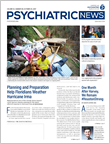Fear of people who are different in some way from the majority population—because of physical characteristics, dress, or language—is a learned response rooted in a neurobiological mechanism. And it can be changed.
So said Mohammed Milad, Ph.D., in an address last month at APA headquarters to more than 50 leaders in industry, government, and the nonprofit sector attending the Cultural Competence and Inclusive Excellence Summit. He is an associate professor of psychiatry at Harvard Medical School and the director of the animal models and behavioral neuroscience lab at Massachusetts General Hospital.
Milad described the network of brain structures that generate day-to-day reactions to perceived differences: the amygdala, where negative, defensive, and protective associations are stored that trigger the feeling of fear; the frontal cortex, which can provide a cognitive regulation of fear; and the hippocampus, which communicates between the amygdala and prefrontal cortex depending on the context of any given scenario or situation.
“We are the product of neuroactivity,” Milad said. “Everything we think and feel is mediated by brain structures, so if you want to understand bias and how to change it, we need to understand where it comes from. A broad understanding of the biology of fear-based bias can be useful in educating people about their emotions and understanding where our biases come from.”
He emphasized that biases can be challenged and changed. “Fear can be inhibited or extinguished,” Milad said. “The brain is the most plastic structure in our anatomy and is amenable to change. We can change the connections that underlie fear and bias and rewire those connections.”
His remarks began a day of small-group discussions aimed at identifying and implementing best practices to develop cultural competence and drive inclusion in organizations of all types, as well as metrics for assessing change.
The all-day event, sponsored by APA, General Motors, and the Ohio State University Wexner Medical Center, followed up on a similar event in 2016, which in turn was catalyzed by the 2015 STEM Diversity Forum convened by the White House Office of Science and Technology Policy. (“STEM” stands for science, technology, engineering, and math.)
“The summit last month at APA, following on the very successful summit two years ago at the White House, addressed how to chart a strategy toward organizational excellence,” said Ranna Parekh, M.D., M.P.H., director of APA’s Division of Diversity and Health Equity. “The most visionary leaders in health care, government, and private industry agree that cultural competency and inclusiveness are critical elements of organizational excellence. We want to thank our partners for making the summit an enormous success.”
Speakers at the summit included, in addition to Milad, Jayne B. Morrow, Ph.D., senior science policy advisor at the National Institute of Standards and Technology at the Department of Commerce; Ted Childs, principal of Ted Childs, LLC, a global strategic diversity consulting firm; and Subha Barry, senior vice president and managing director at Working Mother Media.
After each presentation, participants broke into small groups for workshops in which they were tasked with developing tools and products. Among them:
•
Assessment tools that can be used across public and private sectors to measure cultural competency at an agency or institution.
•
Resources for training administrators and employees in cultural competency, along with cost estimates for implementing such training.
•
An adaptable cross-sector “inclusion scorecard” to track cultural competence and inclusive excellence over time.
Among those attending the summit was psychiatrist Ramaswamy Viswanathan, M.D., the recipient of the 2016 APA George Tarjan Award, which honors a psychiatrist who has advanced the cause of international medical graduates. Viswanathan described a “best practice” from his own practice of consultation/liaison psychiatry (see box).
The summit was preceded the night before by a “networking” event in which Childs delivered a keynote address, followed by remarks by Joan Y. Rede, M.D., dean for diversity and community partnership at Harvard Medical School, and APA President Anita Everett, M.D. In opening remarks, APA CEO and Medical Director Saul Levin, M.D., M.P.H., said that cultural competence has become critical in health care and to the profession of psychiatry and to APA.
In comments to Psychiatric News, Levin said, “We wanted to host the summit here at APA headquarters as a sign to our partners in government and the private sector as well as to our own members that APA strives to be ahead of the curve in this area. I believe psychiatrists in particular need to understand the nature and importance of unconscious bias and its effect on the quality of care for our patients.” ■
Resources related to cultural competency can be found on the APA website
here.

